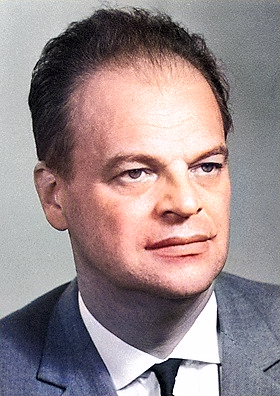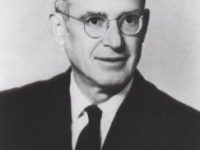
Nikolay Basov (1922 – 20019
On December 14, 1922, Soviet physicist and Nobel Laureate Nikolay Basov was born. For his fundamental work in the field of quantum electronics that led to the development of laser and maser, Basov shared the 1964 Nobel Prize in Physics with Alexander Prokhorov and Charles Hard Townes. The maser is a device that produces coherent electromagnetic waves through amplification by stimulated emission, a principle originally proposed by Albert Einstein in 1917.[4]
Nikolay Basov – Early Years
Nikolay Basov was the son of a professor of the Voronezh Forest Institute who devoted his life to investigation of the influence of forest belts on underground waters and on surface drainage. After finishing secondary school, Nikolay had to join the Kuibyshev Military Medical Academy and left two years later as military doctor‘s assistant. He served in the Soviet Army and took part in the Second World War in the area of the First Ukrainian Front. In December 1945, he was demobilized and entered the Moscow Institute of Physical Engineers where he studied theoretical and experimental physics.
The Development of the Maser
Basov worked on his thesis at the P.N. Lebedev Physical Institute of the Academy of Sciences, U.S.S.R., under the guidance of M.A. Leontovich and A.M. Prochorov. Basov gained his first experiences in the field of quantum radiophysics and attempted to design and build oscillators. Basov successfully defended his doctoral thesis with the title “A Molecular Oscillator“ in 1956. Already in 1954, the theoretical principles describing the operation of a maser were first published by Nikolay Basov and Alexander Prokhorov from Lebedev Institute of Physics. The physicists along with some of his pupils and collaborators continued studying oscillators, focusing on frequency stability, proposing methods of producing slow molecules, and investigating the operation of oscillators with resonators in series. Further, they realized phase stabilization of klystron frequency by means of molecular oscillators, studied transition processes in molecular oscillators, and designed an oscillator utilizing a beam of deuterium ammonia. In the result of these investigations the oscillators with a frequency stability of 10-11 have been realized in 1962.
The Semiconductor Laser
Basov‘s work on quantum oscillators in the optical range began in the late 1950s. In 1961 together with O.N. Krokhin and Yu.M. Popov, Basov proposed three different methods for the obtaining of a negative temperature state in semiconductors in the presence of direct and indirect transitions. In the mid-1960s, semiconductor lasers with electronic excitation have been created and lasers with optical excitation were constructed. Also, the scientists researched on creating more powerful lasers as well as the possibility of laser radiation usage for the obtaining of thermonuclear plasmas. Basov and his associates P.G. Kriukov, Yu.V. Senatsky, and S.D. Zakharov have succeeded in observing for the first time neutron emission in the laser-produced deuterium plasmas in 1968.
The Nobel Prize in Physics
In 1964, together with Charles H. Townes and Prochorow, he was awarded the Nobel Prize in Physics for fundamental work in the field of quantum electronics that led to the design of oscillators and amplifiers based on the maser-laser principle. The award of the Nobel Prize to two Soviet researchers was celebrated by the party and state leadership in Moscow as the “triumph of socialist physics” and made both Bassov and Prokhorov famous and popular at a stroke.
Chemical Lasers
In the field of chemical lasers, Dr. Basov made large contributions in the 1970s. The physicist and his colleagues were able to create a laser that operates on a mixture of deuterium, F and CO2 at the atmospheric pressure. Also, they managed to propose and experimentally develop an elion (electrical pumping of ionized compressed gases) method of gaslaser excitation.
In the same year Basov (in cooperation with E.M. Belenov, V.A. Danilychev and A.F. Suchkov) proposed and developed experimentally an elion (electrical pumping of ionized compressed gases) method of gaslaser excitation. Using this method for a CO2 and N2 mixture compressed to 25 atm, they achieved a great increase of power of the gas laser volume unit compared to the typical low pressure CO2 lasers. In the end of 1970 Basov along with E.P. Markin, A.N. Oraevsky, and A.V. Pankratov presented experimental evidence for the stimulation of chemical reactions by the infrared laser radiation.
Books by Nikolay Basov:
- N. G. Basov, K. A. Brueckner (Editor-in-Chief), S. W. Haan, C. Yamanaka. Inertial Confinement Fusion, 1992, Research Trends in Physics Series published by the American Institute of Physics Press (presently Springer, New York).
- V. Stefan and N. G. Basov (Editors). Semiconductor Science and Technology, Volume 1. Semiconductor Lasers. (Stefan University Press Series on Frontiers in Science and Technology) (Paperback), 1999.
- V. Stefan and N. G. Basov (Editors). Semiconductor Science and Technology, Volume 2: Quantum Dots and Quantum Wells. (Stefan University Press Series on Frontiers in Science and Technology) (Paperback), 1999.
[5] Shaoul Ezekiel, Laser Fundamentals I | MIT Understanding Lasers and Fiberoptics, [5]
References and Further Reading:
- [1] Nikolay Basov Biography at the Nobel Prize Website
- [2] Nikolai Basov at Britannica Online
- [3] Nikolay Basov at Wikidata
- [4] How Albert Einstein Revolutionized Physics, SciHi Blog
- [5] Shaoul Ezekiel, Laser Fundamentals I | MIT Understanding Lasers and Fiberoptics, 2012, MIT OpenCourseWare @ youtube
- [6] O. Krokhin: Obituary Nikolai Gennadievich Basov. In: Physics Today. vol 55, 2002, No. 10, pp. 68–70.
- [7] Timeline for Nikolay Basov, via Wikidata






Pingback: Whewell’s Gazette: year 2, Vol. #23 | Whewell's Ghost
Pingback: Whewell’s Gazette: Year 03, Vol. #18 | Whewell's Ghost